
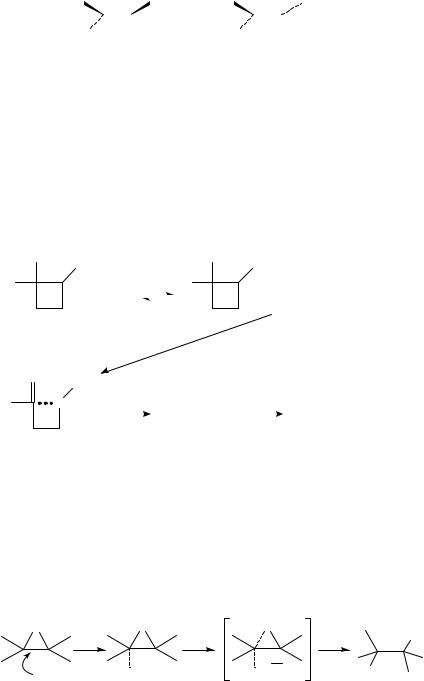
17. Syntheses and uses of isotopically labelled compounds |
1049 |
|||||||
Ph |
|
|
Ph |
Ph |
|
|
Ph |
|
HO |
|
|
|
HO |
|
|
|
|
|
|
|
|
|
|
|
||
|
(440) - cis |
|
(440) - trans |
|
||||
440 - cis (pH 11.6) |
440 - trans (pH 12.01 / D2 O) |
|
||||||
|
|
|
|
kH2 O / kD2 O = 0.68 |
|
|||
9. Deuterium isotope effect in ring opening of 1,2-diphenylcyclobutanols (440)
Cis- and trans-440 with base yield 1,4-diphenylbutan-1-one, 441. In D2O the product incorporates one deuteron at C 4 and varying amounts of deuterium at the enolizable 2-position507 (equation 263). The inverse solvent deuterium isotope effect (kH2O/kD2O = 0.68) and the discrimination isotope effect kH/kD D 0.99 š 0.05 508 support a reaction scheme, in which the alkoxide reacts in the RDS to yield a benzylic anion 442, which in turn yields the deuteriated product 441 (equation 263).
Ph |
|
Ph |
|
|
|
|
Ph |
Ph |
|
|
|
|
|
|
|
|
|
|
|
|
|
|
|
|
|
|
|
|
|
|
|
|
|||
DO |
1 |
|
|
|
|
|
|
−O |
|
|
|
|
|
|
|
|
|
2 |
+ DO− |
|
K |
+ |
D2 O |
|
|
||||||||||
3 |
4 |
|
|
|
|
|
|
|
|||||||||
|
|
|
|
|
|
|
|||||||||||
|
|
|
|
|
|
|
|
|
|
|
|
|
|
|
|
||
(440) |
|
|
|
|
|
|
|
|
|
|
|
|
|
|
|
|
|
|
|
|
|
|
|
|
|
|
|
|
|
|
|
|
|
|
(263) |
δ− |
|
|
|
|
|
|
|
|
|
|
|
|
|
|
|
|
|
O |
δ− Ph |
|
|
O |
|
|
|
O |
|
|
|||||||
|
|
|
|
|
|
|
|
||||||||||
Ph |
C |
+ D2 O |
|
|
|
|
|
− |
D2 O |
|
|
|
|
|
|
|
+ DO− |
|
|
|
|
|
|
|
|
|
|||||||||
|
|
|
|
PhCCH2 CH2 CHPh |
|
|
PhCCH2 CH2 CDHPh |
||||||||||
|
|
|
|
|
|
||||||||||||
H = D or H |
|
|
(442) |
|
|
|
|
|
|
|
(441) |
|
|||||
|
|
|
|
|
|
|
|
|
|
|
|
|
|
|
|
||
In the reaction of benzylic anion with H2O controlled by H O/D O bond ruptures the discrimination (kH/kD) isotope effect should be observed. An ab initio study of the deuterium ˛-secondary KIEs and of the corresponding transition structures in the ring opening of ethylene oxide by different nucleophiles, like NH3, F , OH , NH2 , H , Cl , SH (equation 264), has been carried out509, and the conclusion has been reached that the KIE decreases as the TS becomes more product-like, i.e. tighter. An almost linear correlation between TS geometry and secondary KIE has been found. This correlation is primarily due to bending vibrations, but the absolute value of the secondary KIEs is governed mainly by stretching vibrations and cannot be explained by considering the C˛ H(D) out-of-plane bending vibration only.
O |
O |
r(CO) O |
|
≠ |
− |
|
O |
||||
|
|
|
|
|
|
− |
− |
r(C |
Nu) |
Nu |
|
Nu |
|
|
|||
Nu: |
Nu: |
|
|
|
(264)
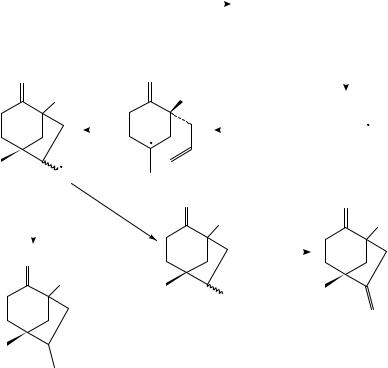
1050 |
Mieczysław Ziełinski´ and Marianna Kanska´ |
10. Deuterium tracer and isotope effect study of Mn(III)-based oxidative free-radical cyclizations
The unsaturated ˇ-keto ester 443 is converted to methylenecyclo[3.2.1]octane, 449, with 2 equiv. of Mn(OAC)3 and 1 equiv. of Cu(OAc)2510 (equation 265). Oxidation of 443 with 2 equiv. of Mn(OAc)3 in AcOH without Cu(OAc)2 provides alkene 449 in 14% only and alkanes 450a and 450b in 7% and 17% yields, respectively510. Oxidation of 443 with 2 equiv. of Mn(pic)3 and 1 equiv. of Cu(OAc)2 in AcOH provides none of alkene 449, 15% of alkane 450 and 69% of oligomeric material. To understand the above observations deuterium tracer and KIE studies have been undertaken511.
|
|
|
|
|
O |
|
|
|
|
|
|
|
|
|
|
OMn(III) |
|
|
|
||||||||||||||
|
|
|
|
|
|
|
|
|
|
|
Mn(OA c )3 |
|
|
|
|
|
|
|
|
|
|
|
|
|
|
|
|
|
|||||
CH2 |
|
C(Me)CH2 CH2 CCHCH2 C |
|
CH2 |
|
|
CH2 |
|
|
C(Me)CH2 CH2 C |
|
|
|
|
|
CCH2 C |
|
|
CH2 |
||||||||||||||
|
|
||||||||||||||||||||||||||||||||
|
|
|
|
|
|
|
|
|
|
|
|
|
|||||||||||||||||||||
|
|
|
|
|
|
|
|
|
|
|
|||||||||||||||||||||||
|
|
|
|
|
|
|
|
|
|
|
|
|
|
|
|
|
|
|
|
|
|
|
|
|
|
|
|
|
|
|
|
|
|
(443) |
|
COOMe |
|
|
|
|
|
|
|
|
(444) |
|
|
|
|
|
|
|
COOMe |
|
|
|
|||||||||||
|
|
|
|
|
|
|
|
|
|
|
|
|
|
|
|
|
|
|
|
|
|
|
|
|
|||||||||
|
|
|
|
|
|
|
|
|
|
|
|
|
|
|
|
|
|
|
|
|
|
|
|||||||||||
|
O |
|
|
|
|
O |
|
|
|
|
|
|
|
|
- Mn(II) |
|
|
|
|
||||||||||||||
|
|
|
|
|
|
|
|
|
|
|
|
|
|
|
|
|
|
|
|
|
|
|
|
|
|
|
|
||||||
|
|
|
COOMe |
|
|
|
|
|
|
COOMe |
|
|
|
|
O |
|
|
|
|||||||||||||||
|
|
|
|
|
|
|
|
|
|
|
|
|
|
|
|
||||||||||||||||||
|
|
|
|
|
|
|
|
|
|
|
|
|
|
|
|
|
|
|
|
|
|
|
|
||||||||||
|
|
|
|
|
|
|
|
|
|
|
|
|
|
CH2 |
|
C(Me)CH2 CH2 |
|
|
|
CCCH2 C |
|
CH2 |
|||||||||||
|
|
|
|
|
|
|
|
|
|
|
|
|
|||||||||||||||||||||
|
|
|
|
|
|
|
|
|
|
|
|
|
|
|
|
|
|
|
|
|
|||||||||||||
|
|
|
|
|
|
|
|
|
|
|
|
|
|
|
|
||||||||||||||||||
|
|
|
|
|
|
|
|
|
|
|
|
|
|
|
|
|
|
|
|
|
|
|
|
|
|
|
|
|
|
|
|
||
|
|
|
|
|
|
|
|
|
|
|
|
|
|
|
|
|
|
|
|
|
|
|
|
|
|
COOMe |
|
|
|
||||
|
|
|
CH2 |
|
|
|
|
|
|
|
|
|
|
|
|
|
|
|
|
|
|
|
|
|
|
|
|
|
|
(265) |
|||
(447) |
|
|
|
|
|
(446) |
|
|
|
|
|
|
(445) |
|
|
|
|
|
|
|
|
|
|||||||||||
|
|
|
|
|
|
|
|
|
|
|
|
|
|
|
|
|
|
|
|
|
|
|
|||||||||||
|
|
|
no Cu(OA c )2 , |
|
|
|
Cu(OA c)2 |
O |
|
|
O |
|
|
|
|||||||||||||||||||
|
|
|
|
|
|
|
|
|
|
|
|||||||||||||||||||||||
|
|
|
|
|
|
|
|
|
|
|
|
|
|
|
|
|
|
|
|
|
|
|
|
|
|
|
|
|
|||||
|
|
|
|
|
|
|
|
|
|
COOMe |
|
|
|
|
|
|
|
|
|
|
|
COOMe |
|||||||||||
|
|
|
solvent or 443 |
|
|
|
|
|
|
|
|
|
|
|
|
|
|
|
|
|
|
||||||||||||
|
|
|
|
|
|
|
|
|
|
|
|
|
|
|
− HOA c |
|
|
|
|||||||||||||||
|
|
|
|
|
|
|
|
|
|
|
|
|
|
|
− CuOA c |
|
|
|
|||||||||||||||
|
O |
|
|
|
|
|
|
|
|
|
|
|
|
|
|||||||||||||||||||
|
|
|
|
|
|
|
|
|
|
|
|
|
|
|
|
|
|
|
|
|
|
|
|
|
|
|
|
|
|
||||
|
|
|
|
|
|
|
|
|
|
|
|
|
|
|
|
|
|
|
|
|
|
|
|
|
|
|
|
|
|
||||
|
|
|
COOMe |
|
|
|
|
|
|
|
|
|
|
|
|
|
|
|
|
|
|
|
|
|
|
|
|
|
|||||
|
|
|
|
|
|
|
|
|
|
|
|
CH2 Cu(OAc)2 |
|
|
|
||||||||||||||||||
|
|
|
|
|
|
|
|
|
|
|
(448) |
|
|
|
|
|
(449) |
|
|
|
|
|
|
|
|
|
|
||||||
(450a) α-Me, (450b) β-Me
(a)The source of hydrogen atom transferred to 447 has been established by carrying
out the oxidative cyclization of 443 in AcOD, CD3COOD, C2H5OD and C2D5OD. No deuterium incorporation in the product has been found, showing that radical 447 abstracts in this case the ˛-hydrogen from 443 to afford alkane 450 and the acyclic radical 445 (equation 266).
(b)The reaction of the ˇ-keto ester 443-D with 2 equiv. of Mn(OAc)3 and Cu(OAc)2 provided 450 in 65% yield, while ˇ-keto ester 443-H provides only 2% of 450 under the
same conditions. Similarly, oxidation of 443-D with 2 equiv. of Mn(pic)3 and 1 equiv. of Cu(OAc)2 in EtOH (proceeding at a slower rate than oxidation of 443-H) increased the yield of 450 from 22% with 443 to 67% with 443-D. In AcOH, the yields of 450
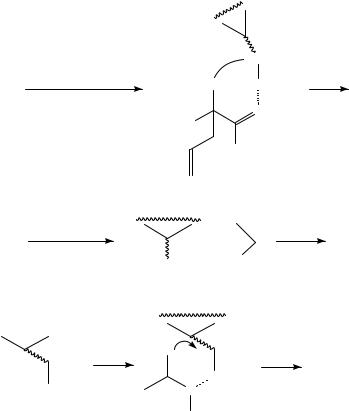
17. Syntheses and uses of isotopically labelled compounds |
1051 |
with both Mn(pic)3 and Mn(OAc)3 oxidants increased to about 60%. No evidence for incorporation of deuterium in alkane 450 has been noted. The suggestion has therefore been made511 that these oxidations proceed according to equation 267: 447 abstracts the ˛-hydrogen from EtOH in these experimental condition and Mn(III) is being consumed in reaction 267. The (kH/kD) of 8.57 has been assessed at RT for the conversion of ˇ- keto ester 443 to manganese enolate 444, which is the RDS in the formation of alkene 449. This value is higher than DKIE caused by zero-point energy effect only. Due to the large deuterium KIE, no D incorporation in 450 has been observed with either 443-D or perdeuteriated solvents. In the cyclization of 443-D, the alkylmanganese picolinate 451 is converted to alkane 450 nearly exclusively via complex 452 because the deuterium transfer from 443-D is slow (equation 267a). 451 is converted to 450 almost exclusively via complex 453 if deuteriated solvent is used, owing to the large DKIE.
 CH2
CH2
443, C2 D5OD or Mn(p ic)3 |
H |
Mn(pic)3 |
|
|
450 + 445 |
|
447 |
|
|
||||
or CD3 COOD, Mn(OA c )3 |
|
O |
|
|
|
|
|
|
|
|
|
|
|
|
MeOOC |
|
|
|
|
|
|
R |
|
|
|
|
|
|
(453) |
|
|
|
|
(266) |
|
|
|
|
|
|
|
443 - D |
+ |
. |
Mn(III) |
|
||
447 |
− H |
+ |
MeCHO |
|||
EtOH, Mn(OA c)3 |
HO |
|
|
(267) |
||
|
|
|
|
|
|
|
|
CH3 |
|
|
|
|
|
|
(452) |
|
|
|
|
|
|
H |
|
|
|
|
. |
|
|
|
|
|
450 + |
|
|
Mn(pic)3 |
|
|
|
MeCHOH |
|
Mn(pic)3 |
|
|
|
|
|
|
O |
|
|
|
|
(267a) |
|
|
|
|
|
|
|
|
|
H |
|
|
|
|
|
(451) |
(452) |
|
|
|
|
|
Both of the above reaction pathways are suppressed if 443-D and perdeuteriated solvents are used simultaneously in cyclization reaction 265. Mainly oligomer and less than 5% of alkane 450 were then produced. This has been explained by different reactivities of radical 445 formed directly from 444 or formed by abstraction of hydrogen atom from 443 through complex 453. The more energetic radicals formed by hydrogen atom transfer from 443, add intermolecularly to an alkene and initiate preferentially oligomerization512, while
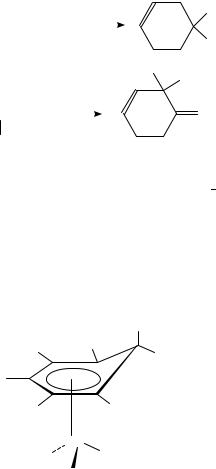
1052 |
Mieczysław Ziełinski´ and Marianna Kanska´ |
the less energetic radicals 445 formed from manganese enolate 444 cyclize preferentially to give the cyclic radical 447.
The deuteriated dimethyl 4-pentenylmalonate (99% D at C˛), 454, and deuteriated acetylenic ˇ-keto ester 455 have been synthesized and applied in oxidation studies511 with the one-electron oxidants Mn(OAc)3 and Cu(OAc)2 in EtOH and AcOH (equations 268a and b).
|
|
|
|
|
|
|
|
|
|
|
|
|
COOMe |
(MeOOC)2 CD(CH2 )3 CH |
|
CH2 |
|
|
|
(268a) |
|||||||
|
|
|
|
||||||||||
|
|
|
|
||||||||||
(454) |
|
|
|
|
|
|
|
|
|
|
COOMe |
||
|
|
|
|
|
|
|
|
|
|
|
|||
|
|
|
|
|
|
|
|
|
|
|
|
COOEt |
|
|
|
O |
|
|
Me |
|
|||||||
|
|
|
|
|
|
||||||||
HC |
|
C(CH2 )2 |
|
|
|
CCDCOOEt |
|
|
|
O |
(268b) |
||
|
|
|
|
||||||||||
|
|
|
|
|
|
||||||||
|
|
|
|
|
|
|
|||||||
|
|
|
|
|
|
||||||||
Me
(455)
11. Deuterium isotope effect in the hydride ion transfer from carbon hydrogen bonds to CS2
The manganese complexes, endo-( 5-C6MenH7 n) Mn(CO)LL0 (n D 0, 3, 6; L,L0 D CO, PR3), transfer hydride ion to CS2 or to COS in THF providing HCS2 and H(O)S , respectively, and the cation [( 6-C6MenH6 n) Mn(CO)LL0 ]C . The deuteriated cyclohexa-
dienyl complex, endo- ( 5-C6Me6D) Mn(CO)2PMe3 derivative, 456, prepared by reducing [( 6-arene) Mn(CO)2PMe3]PF6 cation with NaBD4 in THF, has been used513,514 to study the mechanism of this reaction (equation 269).
D
Me Me
Me
Me
Me |
Me |
Mn
OC PMe3
OC
(456)
The D KIE (kH/kD) in reaction 269 has been found to be 3.2 at 28 °C. Small primary DKIEs are usually associated with unsymmetrical TS in hydrogen transfer and non-linear atomic arrays. The above value of kH/kD observed in this study suggests that C H bond polarization is occurring. No radical species have been found in reaction of 456 with CS2 by ESR study514. Therefore it was suggested that the reduction does not proceed by initial SET from manganese species followed by hydrogen atom transfer but directly by a concerted one-step hydride ion transfer. The course of reaction 269 between 456-H
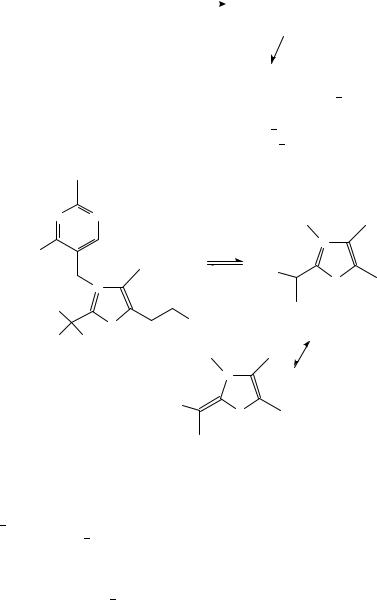
17. Syntheses and uses of isotopically labelled compounds |
1053 |
and CS2 has been followed by IR. The derivative 457 has been formed quantitatively (by IR and 1H NMR). The cationic complexes 457 display spectra similar to the original complexes [( 6-C6Me6) Mn(CO)2PMe3] PF6 except for the presence of dithioformate (HCS2 ) as the counterion. The values of kobs have been determined.
endo-(η5 |
|
C6 Me6 D)Mn(CO2 )PMe3 + CS2 |
|
|
|
([(η6 |
|
C6 Me6 )Mn(CO)2 PMe3 |
]+ S2 CD− |
|
|
|
|
||||||
|
|
|
|||||||
|
(456) - D |
|
|
|
|
(457) - D |
(269) |
||
|
|
|
|
|
|
|
|
|
|
|
|
([(η6 |
|
C6 Me6 )Mn(CO)2 PMe3 ]+ + DCS2 |
− |
||||
|
|
||||||||
12. Deuterium and tritium isotope effects in the base-catalysed C˛ hydron transfer from 2-(1-hydroxylbenzyl)oxythiamin (HBOT; 458)
The primary T and D KIEs for cacodylate-catalysed C˛ hydron transfer from racemic 458 (equation 270), kH/kT D 1.8 š 0.1, obey the Swain Schaad relation515 and are
consistent with incomplete proton transfer in the rate-limiting TS516,517.
N |
N |
|
|
|
|
|
|
|
|
+ |
|
R2 |
|
|
|
N |
|
|
|
+ B |
|
|
|
|
|
|
|
|
|
|
+ |
|
HO |
|
S |
|
|
− |
|
||
|
N |
|
|
|
|
HO |
|
|
|
|
|
|
|
S |
OH |
(459) |
(270) |
L |
R1 |
|
|
||
|
|
|
|
||
(458) |
|
|
N |
+ |
|
|
|
|
|
||
|
|
|
+ |
|
|
|
|
|
LB |
|
HO
S
E or Z
R1 = Ph, R2 = OH, B = (CH3 )2 As(O)OK
pH range: 4:5 − 10, I(ionic strength) = 1.0 M (KNO3 )
The above KIE determinations have been taken as providing evidence against the rate-limiting TS involving diffusion-controlled separation of the buffer acid from the C ˛ carbanion/enamine 459 resonance-stabilized conjugated base515,518.
The TS of the C˛ hydrogen transfer reaction from 458 is probably preceded by the formation of the hydrogen-bonded structure519 460.
13. Deuterium isotope effects in the thermolysis of ˇ-hydoxy esters
It has been proposed520 522 that the ˇ-hydroxy esters undergo thermal decomposition into aldehydes, ketones or esters through a cyclic six-membered TS (equation 271). The
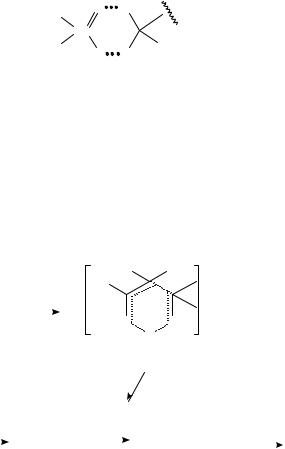
1054 |
Mieczysław Ziełinski´ and Marianna Kanska´ |
|||
|
Me |
O |
HO |
|
|
|
|
|
|
|
|
As |
|
|
|
Me |
− |
H |
Ph |
|
|
O |
|
|
(460)
small value of the primary DIE suggested522 a non-linear and either early or late TS. The secondary DIE kH2 /kD2 , of 1.26š0.06 observed523 in the pyrolysis of 459 is in agreement with the structure 460 of TS shown in equation 271, and compatible with the change of hybridization of C 2 from sp3 to sp2 in the course of the decomposition. According to Streitwelser524 the alpha deuterium IE is caused by the change of a tetrahedral C H bending vibration to an ‘out of plane’ deformation in the TS. The experimental value of 1.26 is consistent with the theoretical calculations525,526 and suggests a late TS, but the 13C and 14C KIE in the rupture of the C˛ Cˇ bond have not been determined. A
D KIE value of 1.22 has been obtained in the sigmatropic rearrangement527 of 3,3,4,4- tetradeuterio-1,5-hexadiene at 200 °C.
|
|
|
|
|
|
|
|
D |
D |
≠ |
|
|
|
|
||
|
|
|
|
|
|
EtO |
|
|
|
|
|
|
|
|
||
EtOOCCD2 C(OH)Me2 |
|
∆ |
|
|
|
|
|
|
|
|
||||||
|
|
|
|
O |
O |
|
|
|
|
|
|
|||||
|
|
|
|
|
|
|
|
|
|
|
|
|
|
|||
|
|
|
|
|
|
|
|
|
H |
|
|
|
|
|
(271) |
|
|
(459) |
|
|
|
|
|
|
|
(460) |
|
|
|
|
|
|
|
|
|
|
|
|
|
EtOC(OH) |
|
CD2 + O |
|
CMe2 |
|
|
|
|||
|
|
|
|
|
|
|
|
|
|
|
||||||
|
|
|
|
|
|
|
|
|
|
|
||||||
|
|
Br2 |
|
|
|
EtOH |
|
|
|
1. Zn |
|
|
|
|||
CD3 |
COOD |
CD2 BrCOOD |
CD2 BrCOOEt |
2. Me |
2 |
CO |
459 |
|||||||||
|
|
|||||||||||||||
|
|
|
+ |
|
|
|
||||||||||
|
|
|
|
|||||||||||||
Py |
H |
|
|
+ |
||||||||||||
|
|
|
|
|
|
|
|
|
|
|
||||||
|
|
|
|
|
|
|
|
|
|
|
|
3. H3 O |
(272) |
|||
|
|
|
|
|
|
|
|
|
|
|
|
|
|
|
||
14. Deuterium and carbon-14 KIE in the thermal decarboxylation of but-3-enoic acid (461) and its derivatives
461 decomposes to propene and carbon dioxide (equation 273):
CH2DCHCH2COOH ! CH3CHDCH2 C CO2 |
273 |
A Sizable primary KIE’s have been observed in the gas-phase thermal decomposition of 2,2-dimethyl-4-phenyl but-3-enoic acid528,529, consistent with a synchronous mechanism via a six-membered cyclic ideal TS, 462. Recently531 the mechanism of thermal decarboxylation of 461 and its derivatives HR1CDCR2CH2COOH (R1 and R2 D H, F, Me, Et and Cl) has been studied again530,531 from the theoretical point of view by ab initio MO calculations and a ‘twisted chair’ six-membered cyclic TS (463) has been constructed.
The best estimate of 156.8 kJ mol 1 for the activation energy is in reasonable agreement with the experimental value of 164 š 7 kJ mol 1 for the unsubstituted case. The Mulliken charges are consistent with the expected charge distribution shown in structure 462. The

17. Syntheses and uses of isotopically labelled compounds |
1055 |
||||||
|
|
|
|
|
|
|
O |
− |
H |
+ |
|
|
|
|
|
δ |
δ |
|
|
O |
|
|
|
|
|
|
|
|
|
|
|
|
|
|
O |
H |
|
|
|
|
|
|
|
H |
H |
|
|
δ− |
δ+ |
|
|
H |
|
||
|
|
|
|
|
|||
|
|
R1 |
|
|
|
||
|
|
|
|
|
|
|
|
|
|
|
O |
|
|
|
|
|
|
|
|
|
R2 |
|
|
(462) |
|
|
|
(463) |
|
|
|
normal-mode vibration frequencies for 461 have been calculated and the zero-point energy (ZPE) corrections and primary k12/k14 values computed using a modified version of the BEBOVIB program532. The values of kH/kD D 2.45 (using Wigner’s equation) and 2.86 (using Bell’s equation) have been computed at 650 °C. The k12/k14 values equal to 1.02 (with Wigner’s correction) and 1.03 (with Bell’s correction) have been calculated529 also, and compared with (k12/k14 exp D 1.035 š 0.010 determined528 for PhCHDCHCMe2COOH at 550 °C. The energy profile for the decarboxylation has been constructed528. The series of transformations of subsequent conformers, preceding the TS formation shown in equation 274, has been presented but the equilibrium thermodynamic isotope effect fractionation related with these transformations from the lowest energy conformation (a) to the reacting conformer (k, l), which is followed by the RDS of reaction (m), have not been calculated.
|
|
|
H |
H |
|
H |
H |
|
|
|
|
O |
|
|
|
|
|||
H |
H |
|
C |
C |
H |
C |
C |
H |
|
C C |
|
|
|
|
|
|
|
||
|
C |
H |
H |
C |
|
H |
C |
|
|
|
|
|
|
||||||
H |
C |
|
O |
|
|
H |
|
|
H |
|
|
O |
C |
O |
C |
||||
|
|
|
|
||||||
|
|
|
|
|
|
||||
H |
|
H |
|
|
O |
|
H |
O |
|
|
|
|
|
|
|
|
|
||
|
|
|
|
|
H |
|
|
|
|
|
|
|
|
|
|
|
|
|
|
|
(a) |
|
|
|
(b) |
|
|
(d) |
|
|
|
|
|
|
|
|
|
|
(274) |
H |
|
H |
H |
|
H |
|
H |
H |
|
C |
C |
H |
C |
C |
H |
|
C |
C |
H |
|
|
H |
|
|
|||||
H H |
|
|
|
H |
|
||||
|
C |
H |
|
C |
|
C |
|
||
|
|
|
|
|
|||||
O |
C |
H |
O |
C |
H |
|
H |
C |
H |
|
O |
||||||||
|
|
O |
|
|
O |
|
|
O |
|
(k)TSeq. |
|
(l) |
|
|
(m) TS |
|
|||
|
|
|
|
|
|
|
n |
|
|
|
|
|
|
|
|
|
products |
|
|

1056 Mieczysław Ziełinski´ and Marianna Kanska´
The conformational change d to l has the highest rotational barrier (of 40.6 kJ mol 1) but is much lower than the activation energy of 215.0 kJ mol 1 (in the HF/3-21 G0 approximation). It is interesting to note that in the earlier studies529 of D KIE in the thermolysis of ˇ-hydroxy olefins, 4-penten-2-ol, 3-butenoic acid and 3-butyn-1-ol as a function of temperature over a large temperature range, the experimental values of kH/kD, corresponding to the transfer of hydrogen between the carbon and oxygen termini in the sigmatropic hydrogen migrations (TS, 464, 465, 466), and the theoretical kH/kD values, corresponding to a fully symmetrical transition state, computed assuming that the zeropoint energy difference of OH and OD stretching vibrations alone determines the kH/kD values, are nearly coincident in the relatively high temperature region (500 °C 390 °C) investigated.
|
C |
C |
|
C |
O |
|
C |
C |
|
C |
C |
|
C |
C |
C |
C |
H |
O |
C |
H |
O |
C |
H O |
|
(464) |
|
|
(465) |
|
|
(466) |
15. Deuterium KIE in the nitrile-forming elimination (E )-O-pivaloylbenzaldoxime (467)
The deuterium KIE in the nitrile-forming elimination of 467 (equation 275), promoted by Et3N MeCN, t-BuOK t-BuOH and t-BuOK DMSO, has been found533 to be dependent on the base solvent variation from t-Bu-OH to DMSO.
|
|
solvent |
|
|
||
PhC(X)DNOOCCMe3 C base ! PhCN C OOCCMe3 |
275 |
|||||
467 X D H(D) |
|
|
||||
At 25.0 š 0.1 °C the values of kH/kD increase in the order 3.67 š 0.31 (Et3N |
|
MeCN), |
||||
|
||||||
4.15 š 0.36 (t-BUOK |
|
t-BuOH), 5.06 š 0.01 (t-BuOK |
|
DMSO). |
|
|
|
|
|
|
|||
Reaction 275, producing benzonitrile quantitatively, has been classified as proceeding according to the E2 mechanism with the cyclic transition state 468. The structure of the TS has not been corroborated by 14C, 15N and 18O KIE studies so far. The change in (kH/kD) value from 4.2 to 5.1 for solvent variation from t-BuOH to DMSO has been interpreted534,535 as arising from the slight shift of the TS from a partly asymmetric product-like one to a more symmetrical one in DMSO, which is a poorer anion-solvating solvent that t-BuOH.
Ph
C N
H O
O C
R3 N
CMe3
(468)

17. Syntheses and uses of isotopically labelled compounds |
1057 |
16. Solvent D KIEs in the acid-catalysed hydrolysis of benzohydroxamic acids
Solvent D KIE in the acid-catalysed hydrolysis of some N-phenyl-4-substituted- benzohydroxamic acids (equation 276), using either H2SO4 or D2SO4 in 20/80 dioxane water medium, have been observed to be equal (Table 4)536.
|
PhN OH |
H3 O+ |
|
OH |
+ |
|
|
|
|||
|
|
C |
+ |
||
R |
C |
R |
NH2 |
||
|
|
|
|
||
|
O |
|
|
O |
OH |
|
(469) |
|
|
|
(276) |
|
|
|
|
|
It has been suggested that reaction 276 proceeds according to the A-2 mechanism shown in equation 277 at low acidities and according to the A-1 unimolecular mechanism at high acidities (equation 278). The protonation behaviour of 469 and the problem whether the hydrolysis proceeds via N- or O-protonated conjugate acid is currently being studied536 541.
|
|
PhN |
OH |
|
|
|
|
|
|
|
OH |
|
|
|
|
|
|
|
|
|
|
+ |
H+ |
|
|
|
|
|
|
|
+ |
|
|
+ H2 O |
|||
R |
|
C |
|
R |
|
|
|
C |
NPh |
|||||||||
|
|
|
|
|||||||||||||||
|
|
|
O |
|
|
|
|
|
|
|
|
OH |
|
|
|
|
||
|
|
|
|
|
|
|
|
|
|
|
|
|
|
|
|
|||
|
|
|
|
|
|
|
|
|
|
|
|
|
slow |
|
|
|
|
|
|
|
|
|
|
|
|
|
|
|
|
|
|
|
|
k1 |
|||
|
|
|
|
|
|
|
|
|
|
|
OH |
|
|
|
|
|
|
|
|
|
|
|
|
|
R |
|
|
|
C |
NPh |
|
|
|
|
|||
|
|
|
|
|
|
|
|
|
|
|
+ |
OH |
(277) |
|||||
|
|
|
|
|
|
|
|
|
|
|
OH2 |
|||||||
|
|
|
|
|
|
|
|
|
|
|
|
|
|
|
||||
|
|
|
OH |
OH |
|
|
|
|
|
|
|
|
|
|
|
|
|
|
|
|
|
|
|
|
|
|
|
|
|
|
|
|
OH |
|
|||
|
|
|
|
|
|
|
|
|
|
|
|
|
|
|
|
|
||
|
|
|
C +NPh |
|
|
|
|
Ph−NH−OH + R |
|
|
|
+ |
|
|
||||
|
R |
|
|
|
|
|
|
|
|
C |
|
|||||||
|
|
|
|
|
|
|
||||||||||||
|
|
|
OH |
H |
|
|
|
|
|
|
|
|
|
|
|
OH |
|
|
|
|
|
|
|
|
|
|
|
|
|
|
|
|
|
|
|
||
|
|
|
|
|
|
|
|
+ |
|
|
|
|
|
|
|
|
||
|
|
|
|
|
|
|
|
|
|
PhNH2 OH + p-RC6 H4 COOH |
||||||||
|
|
TABLE 4. Solvent D KIEs (kH/kD) in the hydrolysis of 469 |
|
|
|
|
|
|
|
|||||||||
|
|
|
|
|
|
|
|
|
||||||||||
|
|
Phenyl x substituent (R) |
|
With 2.9 M D2SO4 |
With 10.4 M D2SO4 |
|||||||||||||
|
|
|
|
|
|
|
|
|
|
|
|
|
|
|
|
|
||
|
|
H |
|
|
|
|
|
0.59 |
|
1.066 |
|
|
|
|
||||
|
|
OMe |
|
|
|
|
|
0.80 |
|
1.11 |
|
|
|
|
||||
|
|
Me |
|
|
|
|
|
0.65 |
|
|
|
|
|
|
|
|
||
|
|
|
|
|
|
|
|
|
|
|
|
|
|
|
||||
|
|
NO2 |
|
|
|
|
|
0.68 |
|
1.17 |
|
|
|
|
||||
|
|
Cl |
|
|
|
|
|
0.93 |
|
1.03 |
|
|
|
|
||||
|
|
F |
|
|
|
|
|
0.76 |
|
1.05 |
|
|
|
|
||||
|
|
|
|
|
|
|
|
|
|
|
|
|
|
|
|
|
|
|

1058 |
|
|
Mieczysław Ziełinski´ and Marianna Kanska´ |
|
|
|||||||
|
|
|
OH |
|
|
|
OH |
+ |
|
|
||
p-RC6 H4 CNPh + H+ |
|
|
|
|
|
slow |
|
O + HO-NHPh |
||||
|
p-RC6 H4 |
|
CNHPh |
p-RC6 H4 C |
|
|||||||
|
|
|
||||||||||
|
|
|
||||||||||
|
||||||||||||
|
|
|
|
|
|
|
+ |
|
|
(278) |
||
|
O |
|
O |
|
||||||||
|
|
|
|
+ |
|
|
H2 O |
|||||
|
|
|
|
|
|
|
||||||
|
|
|
|
|
|
|
|
HONH2 Ph + p-RC6 H4 COOH |
||||
17. D KIE determinations in the ketonizations of methylenic carbons with dioxygen (O2) catalysed by FeII(DPAH)2 complex
D KIEs have been determined542 in the course of studying the mechanism of ketonization of c-C6H12 with FeII (DPAH)2 (DPAH2 D 2,6-dicarboxypyridine) and 18O2 in
py2 2 Ð HOAc543,544. HOOH is the primary product from combination of FeII(DPAH)2 and O2 in (py)2 HOAc. Also, the FeIIICl3/HOOH, 18O2/c-C6H12/(py)4 HOAc system produced545 c-C6H12(18O) and C6H1118OH. FeII(DPAH)2 provides the hydrogen atoms for the formation of H2O2. Addition of O2 to FeII(DPAH)2 results in rapid autooxidation and production of HOOH, which in turn reacts very fast with FeII(DPAH)2 (equation 279 and 280).
FeII (DPAH)2 + O2 |
(py)2 HOA C |
[(DPAH)2 |
FeIV(O2 )] |
FeII(DPA H)2 |
2 FeIII (DPA) (DPAH) |
|||
|
|
|
||||||
|
|
|
|
|
|
|
|
+ HOOH |
|
|
|
|
|
|
|
|
(279) |
|
|
|
|
|
|
− |
+ |
|
FeII (DPAH)2 + HOOH |
|
|
[(DPAH)2 Fe II OOH |
+ pyH] |
||||
|
|
|||||||
|
|
|||||||
|
|
|
|
|
(470) Fenton reagent |
|||
|
|
|
|
|
|
|
|
(280) |
|
|
|
|
|
|
|
|
|
|
|
|
|
|
|
|
Fe II (DPA H)2 |
|
|
|
|
|
|
|
|
||
|
|
|
|
|
2 FeIII (DPA) (DPAH) + 2H2 O |
|||
In the presence of c-C6H12/c-C6D12 and PhSeSePh, c-C6H11SePh and c-C6D11SePh are produced (equation 281). The H2O2 generated from FeII(DPAH)2 and O2 is activated by excess FeII(DPAH)2 and generates these products.
FeII(DPAH)2 C HOOH C c C5H12fc C6H12g C 1/2PhSeSePh ! |
|
FeIII(DPA)(DPAH) C c C5H11SePhfc C6D11SePhg C 2H2O |
281 |
In the FeII(DPAH)2/O2/c-C6H12 (or/and c-C6D12) system the intermediate 470,
produced via nucleophilic addition of HOOH to FeII(DPAH)2, combines with O2 to form the adduct 471 which, reacting with c-C6H12 (and/or c-C6D12)542,544, provides c-C6H10(O)/[and/or c-C6D10(O)] with a KIE of 2.0 (equation 281a). In the case of large HOOH/FeII(PA)2 or (DPAH)2 ratio 472 reacts with another RH molecule (equation 282).
The D KIE in the above reactions of the Fenton reagent have been determined using 1 : 1 cyclohexane/cyclohexane-D12 mixture as a substrate, and calculated from
the product ratios c-C6H10(O)/c-C6D10(O), (c-C6H11)py/(c-C6D11)py) and c-C6H11SePh c-C6D11SePh. In the presence of the carbon radical trap PhSeSePh, the kH/kD D
kc C6H12 /kc C6D12 ratios were in the range 2.2 2.4. In the absence of PhSeSePh the kH/kD ratios were in the range 2.0 2.1. The production of (c-C6D11)py in FeII(DPAH)/HOOH/Ar
